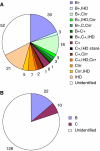Viral hepatitis-associated intrahepatic cholangiocarcinoma shares common disease processes with hepatocellular carcinoma
- PMID: 19436294
- PMCID: PMC2695699
- DOI: 10.1038/sj.bjc.6605063
Viral hepatitis-associated intrahepatic cholangiocarcinoma shares common disease processes with hepatocellular carcinoma
Abstract
Bile duct cells and hepatocytes differentiate from the same hepatic progenitor cells. To investigate the possible association of viral hepatitis B and C with intrahepatic cholangiocarcinoma (ICC), we conducted a retrospective case-control study using univariate and multivariate logistic analyses to identify risk factors for ICC. Besides hepatic lithiasis (25.6%; P<0.001), seropositivity for hepatitis B surface antigen (37.5% of all ICC patients; odds ratio (OR) =4.985, P<0.001) and seropositivity for hepatitis C antibodies (13.1%; OR=2.709; P=0.021) are the primary independent risk factors for ICC. Cirrhosis exerted synergic effects on the development of ICC. We compared the age distributions of viral-hepatitis associated ICC to that of viral hepatitis-associated hepatocellular carcinoma (HCC). The mean age of ICC patients with viral hepatitis B (56.4+/-11.1 years) were 9 years younger than that of ICC patients with viral hepatitis C (65.6+/-9.17 years), similar to that observed in HCC. The incidence ratio of HCC : ICC : CHC (combined hepatocellular cholangiocarcinoma) in our population was 233 : 17 : 1 consistent with the theoretic ratio of hepatocyte number to cholangiocyte number in the liver. Our findings indicated that both viral hepatitis-associated ICC and HCC shared common disease process for carcinogenesis and, possibly, both arose from the hepatic progenitor cells.
Figures


References
-
- Alison MR (2006) Liver cancer: a disease of stem cells? Panminerva Med 48: 165–174 - PubMed
-
- Barajas M, Franchi F, Clavel C, Aranguren XL, Kramer MG, Abizanda G, Merino J, Moreno C, Garate L, Guitart A, Narvaiza I, Gutierrez-Perez M, Riezu-Boj JI, Berasain C, Prieto J, Prosper F (2007) Multipotent adult progenitor cells (MAPC) contribute to hepatocarcinoma neovasculature. Biochem Biophys Res Commun 364: 92–99 - PubMed
-
- Ben-Menachem T (2007) Risk factors for cholangiocarcinoma. Eur J Gastroenterol Hepatol 19: 615–617 - PubMed
-
- Bhagat V, Javle M, Yu J, Agrawal A, Gibbs JF, Kuvshinoff B, Nava E, Iyer R (2006) Combined hepatocholangiocarcinoma: case-series and review of literature. Int J Gastrointest Cancer 37: 27–34 - PubMed
Publication types
MeSH terms
LinkOut - more resources
Full Text Sources
Medical

